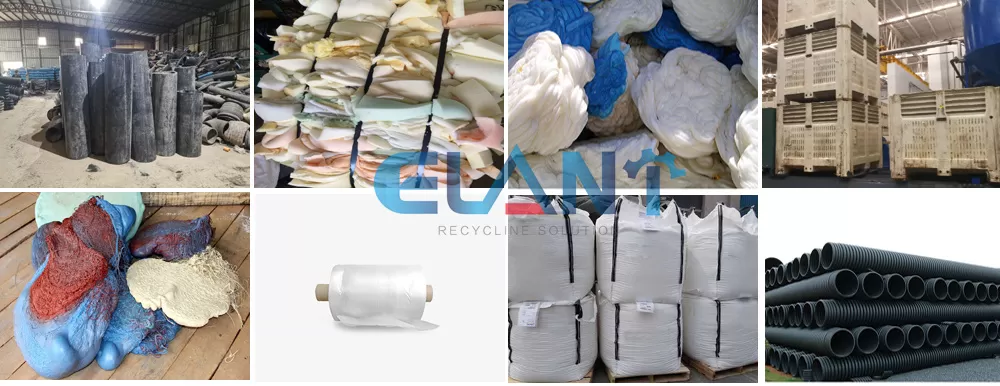In the world of plastic recycling and waste management, plastic shredders and plastic crushers are essential machines that serve distinct roles in the material size reduction process. While both are used to break down plastic waste into smaller fragments, their mechanisms, applications, and output characteristics differ significantly. Understanding the difference between a plastic shredder and a plastic crusher is crucial for industries involved in recycling, manufacturing, or environmental management.
What Is a Plastic Shredder?
A plastic shredder is an industrial machine designed to reduce large volumes of plastic waste into uniform shreds or strips. These machines are built with strong rotating shafts fitted with blades or cutters that tear plastic material into smaller pieces.

How Plastic Shredders Work
Plastic shredders typically use a low-speed, high-torque mechanism to shear materials. The plastic waste is fed into a hopper and pulled into the cutting chamber by rotating shafts. The blades then shred the material into strips or chunks, depending on the screen size and cutter configuration.
Types of Plastic Shredders
Single-shaft shredder – Used for uniform and low-volume shredding needs.
Double-shaft shredder – Ideal for high-volume applications and tougher plastic materials.
Quad-shaft shredder – Provides more refined shredding with improved size consistency.
Advantages of Plastic Shredders
Effective for bulky plastic items (e.g., drums, pipes, large containers)
Can handle a variety of materials: PP, PE, PET, ABS, PVC, etc.
Lower speed operation reduces noise and wear
Suitable for initial size reduction before further processing
What Is a Plastic Crusher?
A plastic crusher, also known as a plastic granulator, is designed to crush plastic materials into small granules or flakes. Unlike shredders, crushers operate at higher speeds and are used for final size reduction.
How Plastic Crushers Work
Plastic crushers utilize high-speed rotating blades that cut plastic material against a fixed blade inside a grinding chamber. The plastic is crushed into granules or flakes that pass through a screen, determining the final particle size.
Key Components of a Plastic Crusher
Rotating cutting blades (rotor)
Fixed stationary blades (stator)
Screen for size control
Motor and feeding hopper
Advantages of Plastic Crushers
Produces finer and more uniform granules
Suitable for regrinding in manufacturing processes
Ideal for crushing plastic film, bottles, sheets, and injection molding sprues
High throughput and fast operation
Key Differences Between Plastic Shredder and Plastic Crusher
| Feature | Plastic Shredder | Plastic Crusher |
|---|---|---|
| Working Principle | Low-speed, high-torque shearing | High-speed, low-torque cutting |
| Output Size | Shredded strips or chunks | Granules or flakes |
| Material Suitability | Suitable for large, bulky plastic waste | Best for thinner and smaller plastic items |
| Noise and Wear | Quieter, less wear due to low-speed operation | Louder, faster blade wear due to high-speed rotation |
| Applications | Pre-processing or volume reduction before further grinding | Final size reduction for recycling or reuse |
| Screen System | Optional or used for larger sizes | Built-in for controlled particle size |
Applications of Plastic Shredders and Crushers
Common Uses of Plastic Shredders
Reducing size of large plastic containers and drums
Shredding of plastic pipes, car bumpers, pallets, and production scrap
Preparing plastic materials for further granulation or washing
Used in MRFs (Material Recovery Facilities) and plastic recycling plants
Common Uses of Plastic Crushers
Crushing of plastic bottles (PET, HDPE)
Granulating film and sheet materials
Recycling plastic waste from injection molding or blow molding processes
Producing plastic granules for reuse in manufacturing
Choosing the Right Machine for Your Needs
When deciding whether to invest in a plastic shredder or crusher, consider the following:
Material Type and Size: Large, rigid plastics may require shredders; small or thin materials are better suited for crushers.
Output Size Requirement: If you need fine granules for reprocessing, crushers are ideal. For preliminary size reduction, shredders are better.
Throughput Volume: Crushers typically offer higher speed and output, while shredders are designed for bulkier materials with slower throughput.
Integration with Recycling Line: Shredders often serve as the first step in a recycling system, followed by crushers for further size reduction.
In many cases, both machines are used in combination — shredders for rough pre-shredding, and crushers for final granulation.
Benefits of Efficient Plastic Size Reduction
Investing in the right plastic size reduction equipment can offer several advantages:
Improved Recycling Efficiency: Smaller, uniform plastic particles are easier to wash, melt, or pelletize.
Cost Savings: Reusing in-house plastic waste reduces material costs and disposal fees.
Environmental Impact: Reducing plastic waste helps support sustainability goals and regulatory compliance.
Operational Productivity: Automating shredding and crushing processes minimizes labor and increases throughput.
Conclusion
Although plastic shredders and plastic crushers both serve the purpose of reducing plastic waste size, they function differently and cater to different stages of the recycling or production process. Shredders are built for heavy-duty, initial reduction, while crushers specialize in finer granulation for reuse or reprocessing.
Understanding the difference between a plastic shredder and a plastic crusher is essential for selecting the right equipment, optimizing your recycling workflow, and achieving maximum efficiency in waste management or plastic production. Whether you’re setting up a recycling facility or aiming to reduce plastic waste in a manufacturing environment, choosing the right machine can greatly impact your bottom line and sustainability efforts.
